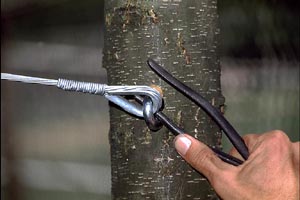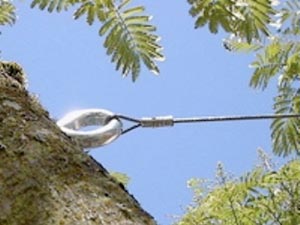Cabling and bracing secures, supports and strengthens the stability of your tree. This procedure promotes good health and can prolong the life of your tree.
Cabling involves installing steel cables between major limbs to reduce the strain and help support the tree. Cabling also helps reduce stress damage from high winds and excess ice or snow weight.
For large, weak, or split crotches, bracing is used to give direct support and reduce twisting strain on the tree. A metal rod is inserted through the crotch and two more cables are placed above it.
Cabling and bracing are the two most common forms of structural support for trees They involve installing flexible cables or rigid rods to reduce the chances of failure of defective unions.
cables are installed high in the tree, at least 2/3 the distance from the defect to the crown rods are installed much lower, just above and/or below the defect cables are always stronger than rods because of their greater leverage cables can be used alone, but bracing is always supplemented with cables
When would you use such a technique?
There are three major uses of cabling and bracing:
prevention: to reduce the chance of failure on a healthy tree with structural weakness
Example: a specimen bur oak in good condition but having large limbs with "V-crotches"
restoration: to prolong the existence of a damaged tree
Example: a large sugar maple that lost one of its leaders in a storm, leaving the others suddenly exposed and vulnerable to further damage


